
Nevada Falls marks where the Merced River plummets almost 600 through a joint in the Little Yosemite Valley, shooting out from a sheer granite cliff and then down to a boulder pile far below.
Location: Nevada Falls, Yosemite National Park, California
Image ID: 16114
Location: Nevada Falls, Yosemite National Park, California
Image ID: 16114

Nevada Falls, with Liberty Cap (center) and Half Dome (left). Nevada Falls marks where the Merced River plummets almost 600 feet through a joint in the Little Yosemite Valley, shooting out from a sheer granite cliff and then down to a boulder pile far below.
Location: Nevada Falls, Yosemite National Park, California
Image ID: 16115
Location: Nevada Falls, Yosemite National Park, California
Image ID: 16115

Devil's Postpile, a spectacular example of columnar basalt. Once molten and under great pressure underground, the lava that makes up Devil's Postpile cooled evenly and slowly, contracting and fracturing into polygonal-sided columns. The age of the formation is estimated between 100 and 700 thousand years old. Sometime after the basalt columns formed, a glacier passed over the formation, cutting and polishing the tops of the columns. The columns have from three to seven sides, varying because of differences in how quickly portions of the lava cooled.
Location: Devils Postpile National Monument, California
Image ID: 23266
Location: Devils Postpile National Monument, California
Image ID: 23266
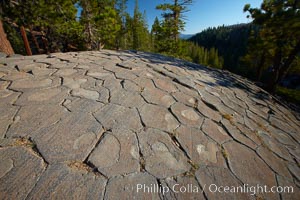
Devil's Postpile, a spectacular example of columnar basalt. Once molten and under great pressure underground, the lava that makes up Devil's Postpile cooled evenly and slowly, contracting and fracturing into polygonal-sided columns. The age of the formation is estimated between 100 and 700 thousand years old. Sometime after the basalt columns formed, a glacier passed over the formation, cutting and polishing the tops of the columns. The columns have from three to seven sides, varying because of differences in how quickly portions of the lava cooled.
Location: Devils Postpile National Monument, California
Image ID: 23267
Location: Devils Postpile National Monument, California
Image ID: 23267

Devil's Postpile, a spectacular example of columnar basalt. Once molten and under great pressure underground, the lava that makes up Devil's Postpile cooled evenly and slowly, contracting and fracturing into polygonal-sided columns. The age of the formation is estimated between 100 and 700 thousand years old. Sometime after the basalt columns formed, a glacier passed over the formation, cutting and polishing the tops of the columns. The columns have from three to seven sides, varying because of differences in how quickly portions of the lava cooled.
Location: Devils Postpile National Monument, California
Image ID: 23285
Location: Devils Postpile National Monument, California
Image ID: 23285

Devil's Postpile, a spectacular example of columnar basalt. Once molten and under great pressure underground, the lava that makes up Devil's Postpile cooled evenly and slowly, contracting and fracturing into polygonal-sided columns. The age of the formation is estimated between 100 and 700 thousand years old. Sometime after the basalt columns formed, a glacier passed over the formation, cutting and polishing the tops of the columns. The columns have from three to seven sides, varying because of differences in how quickly portions of the lava cooled.
Location: Devils Postpile National Monument, California
Image ID: 23281
Location: Devils Postpile National Monument, California
Image ID: 23281

Devil's Postpile, a spectacular example of columnar basalt. Once molten and under great pressure underground, the lava that makes up Devil's Postpile cooled evenly and slowly, contracting and fracturing into polygonal-sided columns. The age of the formation is estimated between 100 and 700 thousand years old. Sometime after the basalt columns formed, a glacier passed over the formation, cutting and polishing the tops of the columns. The columns have from three to seven sides, varying because of differences in how quickly portions of the lava cooled.
Location: Devils Postpile National Monument, California
Image ID: 23282
Location: Devils Postpile National Monument, California
Image ID: 23282

Devil's Postpile, a spectacular example of columnar basalt. Once molten and under great pressure underground, the lava that makes up Devil's Postpile cooled evenly and slowly, contracting and fracturing into polygonal-sided columns. The age of the formation is estimated between 100 and 700 thousand years old. Sometime after the basalt columns formed, a glacier passed over the formation, cutting and polishing the tops of the columns. The columns have from three to seven sides, varying because of differences in how quickly portions of the lava cooled.
Location: Devils Postpile National Monument, California
Image ID: 23283
Location: Devils Postpile National Monument, California
Image ID: 23283

Devil's Postpile, a spectacular example of columnar basalt. Once molten and under great pressure underground, the lava that makes up Devil's Postpile cooled evenly and slowly, contracting and fracturing into polygonal-sided columns. The age of the formation is estimated between 100 and 700 thousand years old. Sometime after the basalt columns formed, a glacier passed over the formation, cutting and polishing the tops of the columns. The columns have from three to seven sides, varying because of differences in how quickly portions of the lava cooled.
Location: Devils Postpile National Monument, California
Image ID: 23284
Location: Devils Postpile National Monument, California
Image ID: 23284
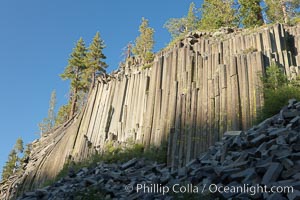
Devil's Postpile, a spectacular example of columnar basalt. Once molten and under great pressure underground, the lava that makes up Devil's Postpile cooled evenly and slowly, contracting and fracturing into polygonal-sided columns. The age of the formation is estimated between 100 and 700 thousand years old. Sometime after the basalt columns formed, a glacier passed over the formation, cutting and polishing the tops of the columns. The columns have from three to seven sides, varying because of differences in how quickly portions of the lava cooled.
Location: Devils Postpile National Monument, California
Image ID: 23286
Location: Devils Postpile National Monument, California
Image ID: 23286
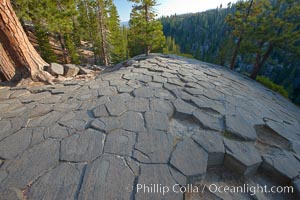
Devil's Postpile, a spectacular example of columnar basalt. Once molten and under great pressure underground, the lava that makes up Devil's Postpile cooled evenly and slowly, contracting and fracturing into polygonal-sided columns. The age of the formation is estimated between 100 and 700 thousand years old. Sometime after the basalt columns formed, a glacier passed over the formation, cutting and polishing the tops of the columns. The columns have from three to seven sides, varying because of differences in how quickly portions of the lava cooled.
Location: Devils Postpile National Monument, California
Image ID: 23287
Location: Devils Postpile National Monument, California
Image ID: 23287

Brain rocks. Sandstone is curiously eroded through the forces water and wind acting over eons. Cracks and joints arise when water freezes and expands repeatedly, braking apart the soft sandstone.
Location: North Coyote Buttes, Paria Canyon-Vermilion Cliffs Wilderness, Arizona
Image ID: 20747
Location: North Coyote Buttes, Paria Canyon-Vermilion Cliffs Wilderness, Arizona
Image ID: 20747

Geometric joints and cracks form in eroding sandstone.
Location: North Coyote Buttes, Paria Canyon-Vermilion Cliffs Wilderness, Arizona
Image ID: 20610
Location: North Coyote Buttes, Paria Canyon-Vermilion Cliffs Wilderness, Arizona
Image ID: 20610

Sandstone joints. These cracks and joints are formed in the sandstone by water that seeps into spaces and is then frozen at night, expanding and cracking the sandstone into geometric forms.
Location: North Coyote Buttes, Paria Canyon-Vermilion Cliffs Wilderness, Arizona
Image ID: 20748
Location: North Coyote Buttes, Paria Canyon-Vermilion Cliffs Wilderness, Arizona
Image ID: 20748
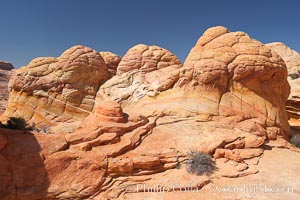
Brain rocks. Sandstone is curiously eroded through the forces water and wind acting over eons. Cracks and joints arise when water freezes and expands repeatedly, braking apart the soft sandstone.
Location: North Coyote Buttes, Paria Canyon-Vermilion Cliffs Wilderness, Arizona
Image ID: 20750
Location: North Coyote Buttes, Paria Canyon-Vermilion Cliffs Wilderness, Arizona
Image ID: 20750

Brain rocks. Sandstone is curiously eroded through the forces water and wind acting over eons. Cracks and joints arise when water freezes and expands repeatedly, braking apart the soft sandstone.
Location: North Coyote Buttes, Paria Canyon-Vermilion Cliffs Wilderness, Arizona
Image ID: 20754
Location: North Coyote Buttes, Paria Canyon-Vermilion Cliffs Wilderness, Arizona
Image ID: 20754

Joints and bolders in the rock formations of Joshua Tree National Park.
Location: Joshua Tree National Park, California
Image ID: 11974
Location: Joshua Tree National Park, California
Image ID: 11974

Joints and bolders in the rock formations of Joshua Tree National Park.
Location: Joshua Tree National Park, California
Image ID: 11975
Location: Joshua Tree National Park, California
Image ID: 11975

Joints and bolders in the rock formations of Joshua Tree National Park.
Location: Joshua Tree National Park, California
Image ID: 11976
Location: Joshua Tree National Park, California
Image ID: 11976
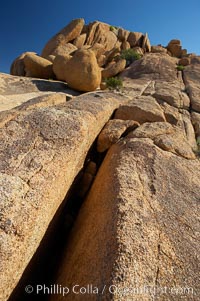
Joints and bolders in the rock formations of Joshua Tree National Park.
Location: Joshua Tree National Park, California
Image ID: 11977
Location: Joshua Tree National Park, California
Image ID: 11977

Joints and bolders in the rock formations of Joshua Tree National Park.
Location: Joshua Tree National Park, California
Image ID: 11978
Location: Joshua Tree National Park, California
Image ID: 11978

Vernal Falls and the Merced River, at peak flow in late spring. Hikers ascending the Mist Trail visible at right. Vernal Falls drops 317 through a joint in the narrow Little Yosemite Valley.
Location: Vernal Falls, Yosemite National Park, California
Image ID: 16109
Location: Vernal Falls, Yosemite National Park, California
Image ID: 16109

Vernal Falls at peak flow in late spring. Hikers are visible at the precipice of the waterfall. Viewed from the John Muir Trail. Vernal Falls drops 317 through a joint in the narrow Little Yosemite Valley.
Location: Vernal Falls, Yosemite National Park, California
Image ID: 16110
Location: Vernal Falls, Yosemite National Park, California
Image ID: 16110

Vernal Falls and the Merced River, at peak flow in late spring. Hikers ascending the Mist Trail visible at right. Vernal Falls drops 317 through a joint in the narrow Little Yosemite Valley.
Location: Vernal Falls, Yosemite National Park, California
Image ID: 16111
Location: Vernal Falls, Yosemite National Park, California
Image ID: 16111
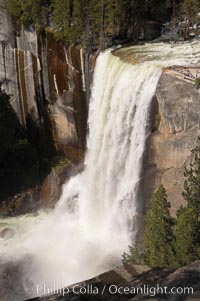
Vernal Falls at peak flow in late spring. Hikers are visible at the precipice of the waterfall. Viewed from the John Muir Trail. Vernal Falls drops 317 through a joint in the narrow Little Yosemite Valley.
Location: Vernal Falls, Yosemite National Park, California
Image ID: 16112
Location: Vernal Falls, Yosemite National Park, California
Image ID: 16112

Vernal Falls and the Merced River, at peak flow in late spring. Hikers ascending the Mist Trail visible at right. Vernal Falls drops 317 through a joint in the narrow Little Yosemite Valley.
Location: Vernal Falls, Yosemite National Park, California
Image ID: 16113
Location: Vernal Falls, Yosemite National Park, California
Image ID: 16113
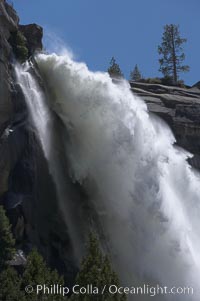
Nevada Falls marks where the Merced River plummets almost 600 through a joint in the Little Yosemite Valley, shooting out from a sheer granite cliff and then down to a boulder pile far below.
Location: Nevada Falls, Yosemite National Park, California
Image ID: 16116
Location: Nevada Falls, Yosemite National Park, California
Image ID: 16116

Nevada Falls, with Liberty Cap rising above it. Nevada Falls marks where the Merced River plummets almost 600 through a joint in the Little Yosemite Valley, shooting out from a sheer granite cliff and then down to a boulder pile far below.
Location: Nevada Falls, Yosemite National Park, California
Image ID: 16117
Location: Nevada Falls, Yosemite National Park, California
Image ID: 16117

Nevada Falls marks where the Merced River plummets almost 600 through a joint in the Little Yosemite Valley, shooting out from a sheer granite cliff and then down to a boulder pile far below.
Location: Nevada Falls, Yosemite National Park, California
Image ID: 16118
Location: Nevada Falls, Yosemite National Park, California
Image ID: 16118

Nevada Falls marks where the Merced River plummets almost 600 through a joint in the Little Yosemite Valley, shooting out from a sheer granite cliff and then down to a boulder pile far below.
Location: Nevada Falls, Yosemite National Park, California
Image ID: 16119
Location: Nevada Falls, Yosemite National Park, California
Image ID: 16119